
~~~~~~~~~~~~~~~~~~~~~~~~~~~~~~~~~~~~~~~~~~~
Live Earth Farm (Com)Post
4th Harvest Week, Winter 2006/2007
January 10th, 2007 [Happy New Year!!!]
~~~~~~~~~~~~~~~~~~~~~~~~~~~~~~~~~~~~~~~~~~~
In this issue
--Greetings from Farmer Tom
--Winter Share Box Pick-up Happiness
--More pictures from around the farm
--What's in the box this week
--Notes from Debbie's Kitchen (or, Recipes... lots!!!!)
"If you observe well your own heart will answer. "
~ R.A. Schwaller de Lubicz
Greetings from Farmer Tom
~~~~~~~~~~~~~~~~~~~~~~~~~~~~~~~~~~~~~~~~~~~~~~~~
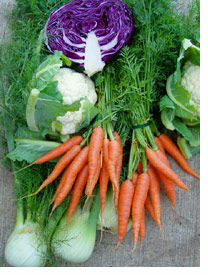 Eating locally grown, in-season vegetables and fruits takes on a whole
new meaning in the winter. One becomes a lot more aware of the crops we
take for granted year round but which may not necessarily be grown in
our bio-region. Cucumbers, tomatoes, green beans, peppers and eggplant
often travel long distances to make it to a grocery shelf near you. Even
leafy greens such as lettuce, spinach and arugula may be difficult to
get in the middle of winter, as although we are blessed with great weather
here in California, crops are all growing very slowly. The short days
and the cold nights reduce the uptake of nutrients and bring the activity
of soil microorganisms almost to a halt.
Eating locally grown, in-season vegetables and fruits takes on a whole
new meaning in the winter. One becomes a lot more aware of the crops we
take for granted year round but which may not necessarily be grown in
our bio-region. Cucumbers, tomatoes, green beans, peppers and eggplant
often travel long distances to make it to a grocery shelf near you. Even
leafy greens such as lettuce, spinach and arugula may be difficult to
get in the middle of winter, as although we are blessed with great weather
here in California, crops are all growing very slowly. The short days
and the cold nights reduce the uptake of nutrients and bring the activity
of soil microorganisms almost to a halt.
It may be a challenge to prepare meals with winter crops,
not only do they take a little more time to prepare but you have to become
a bit of an adventurer by preparing larger portions that last for several
meals.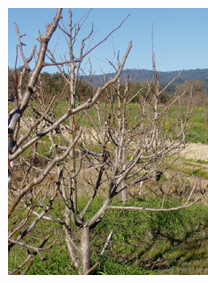 Winter shares are mostly about greens, and although you might feel
overwhelmed by them they are the most flavorful and nutritious at this
time of year, packed with antioxidants, fiber, vitamins and minerals.
I love kale; right now the leaves have turned almost red from the frost,
but if you try them slightly steamed or even raw you'll be surprised at
how mild and sweet they are. The cold converts a lot of the starches into
sugars, which in turn helps the plant fend off heavy frosts. Both green
and red cabbage, another versatile easy to use winter crop, will be abundant
for the next two months.Although grated raw into a salad is popular, I
still like to make my mother's favorite recipe, a kind of sweet-and-sour
red cabbage. Otherwise, just stir-fry, sauté, or chop them into a soup. The
cauliflower we planted in September is all maturing, so right now we have
an abundance of white cauliflower. Each share should receive at least
one or two of each. We also have some purple cauliflower, but I’m
not sure yet how much. Hopefully enough so that some of the shares, if
not all, will have purple cauliflower as well.
Winter shares are mostly about greens, and although you might feel
overwhelmed by them they are the most flavorful and nutritious at this
time of year, packed with antioxidants, fiber, vitamins and minerals.
I love kale; right now the leaves have turned almost red from the frost,
but if you try them slightly steamed or even raw you'll be surprised at
how mild and sweet they are. The cold converts a lot of the starches into
sugars, which in turn helps the plant fend off heavy frosts. Both green
and red cabbage, another versatile easy to use winter crop, will be abundant
for the next two months.Although grated raw into a salad is popular, I
still like to make my mother's favorite recipe, a kind of sweet-and-sour
red cabbage. Otherwise, just stir-fry, sauté, or chop them into a soup. The
cauliflower we planted in September is all maturing, so right now we have
an abundance of white cauliflower. Each share should receive at least
one or two of each. We also have some purple cauliflower, but I’m
not sure yet how much. Hopefully enough so that some of the shares, if
not all, will have purple cauliflower as well.
Since our selection is more limited, and since you will only be receiving a share every other week for the rest of the winter share season, I am planning to increase the quantity of each item in order to carry you through until the next fresh batch arrives. Make sure you take the extra steps to prep and store certain items in order to preserve their freshness, i.e. always take the tops of the carrots and separate the leaves from the beets [don’t pitch those beet greens!! They’re good as chard! – Debbie]. This way the roots will stay crisp much longer.
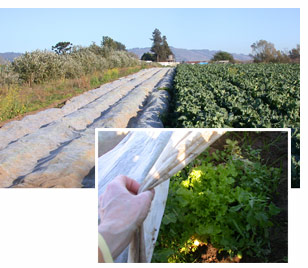 A small patch of lettuce is
growing nicely under the protection of a row cover blanket which keeps
the hard rains and frost from damaging the tender leaves. In the February,
they should be big enough to make a nice salad. Earlier plantings of broccoli
are also starting to mature, and by March who knows... bon appetìt
for now!
A small patch of lettuce is
growing nicely under the protection of a row cover blanket which keeps
the hard rains and frost from damaging the tender leaves. In the February,
they should be big enough to make a nice salad. Earlier plantings of broccoli
are also starting to mature, and by March who knows... bon appetìt
for now! <back to top>
Winter Share Box Pick-up Happiness
~~~~~~~~~~~~~~~~~~~~~~~~~~~~~~~~~~~~~~~~~~~~~~~~
Sometimes there is sheer joy in the CSA experience. I got this exuberant
note from a member and asked if I could share it in a newsletter. She was
concerned she might seem a little too 'fruit-loopy,' but I assured her
that other members will read this and be relieved to know they're not the
only ones that feel like this. Heck, I found her joy to be completely infectious!
Here's her note. See if you don't agree. – Debbie
"Hi Debbie – I almost wrote you the first week of the winter share, to
tell you how happy I was Tom was able to put this together. As I was
driving to pick up the first share, I was humming to myself, and once
I got to my pick-up site, I was practically giggling out loud; I was
so happy I was giddy! You know that tingly, tickly, belly flip feeling
that you get on good roller coasters? I even had a bit of that sensation
as I was picking the stuff up, I kid you not! I love it! I will definitely
drop Tom a line; thank goodness he does what he does." – Anonymous
<back to top>
More pictures from around the farm
~~~~~~~~~~~~~~~~~~~~~~~~~~~~~~~~~~~~~~~~~~~~~~~~
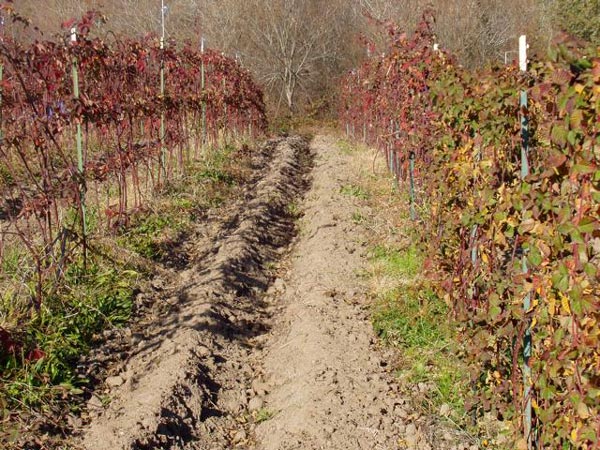
Blackberry canes in winter.
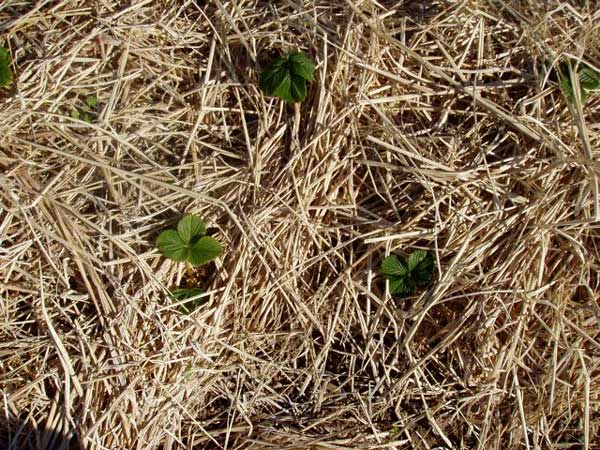
Baby strawberry plants!
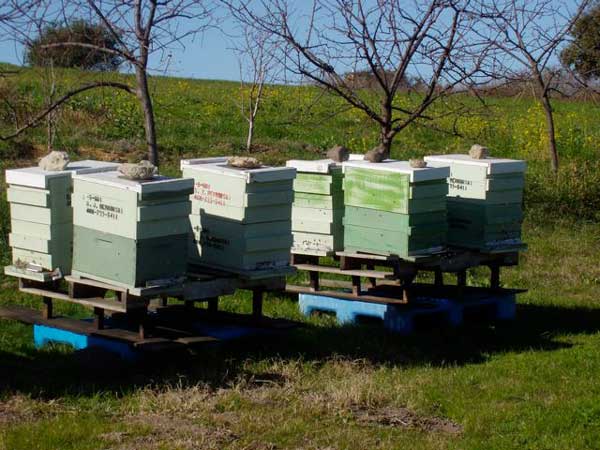
Our new honeybee hives courtesy of Steve Demkowski, beekeeper.
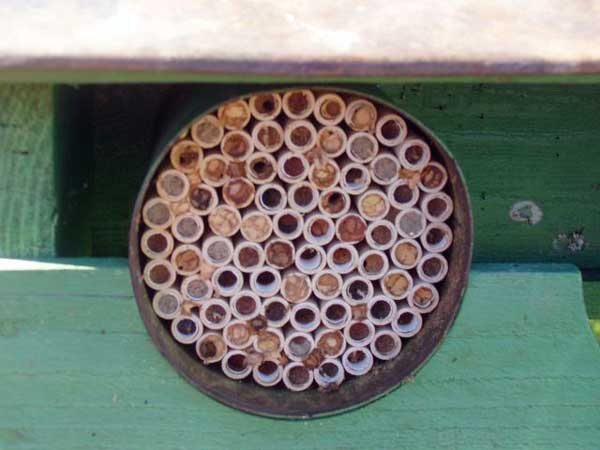
Closeup of custom hive for California native bees. Hive designed by Steve
Demkowski.
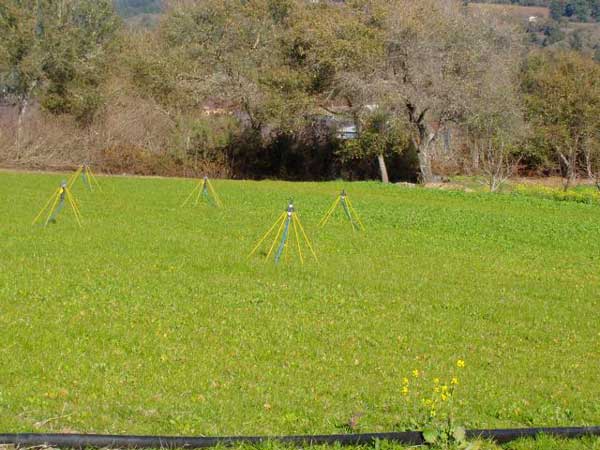
Tom's new chicken pasture in the making. It's a combination of rye grass
and clover which not only provides pasture but also supresses weeds. (Chickens
to be added later.)
<back to top>
What's in the box
~~~~~~~~~~~~~~~~~~~~~~~~~~~~~~~~~~~~~~~~~~~~~~~~
2 lbs. apples (from Billy Bob's Orchard)
1 bunch golden beets
1 bunch red beets
1 head green cabbage
1 head red cabbage
1 bunch carrots
2 to 3 heads of white (and possibly purple) cauliflower
2 bunches of chard
1 large fennel (Lakeside Organic Gardens)
1 bunch Red Russian kale
<back to top>
Notes from Debbie's Kitchen
~~~~~~~~~~~~~~~~~~~~~~~~~~~~~~~~~~~~~~~~~~~~~~~~
Welcome back everyone! I've got a nice lineup of recipes for you, starting with a very interesting recipe which I'm anxious to try called "Lumbardy Pie," a savory beet, cheddar and currant pie.
Lumdardy Pie
Member Piper McNulty who submitted this says, “This is an amazing recipe for plain red beets (does not work well with striped or yellow beets, must be solid red). It is a savory pie to be served as a side or main dish. It is from ‘The good Huswifes Handmaide for the Kitchin,’ by John Partridge, 1594 - given to me by my cousin, who was a member of the Society for Creative Anachronism in college. It sounds crazy but it looks gorgeous and tastes amazing - (and I don't like red beets particularly). Slices are a beautiful hot pink and hold together firmly.”
1 1b. fresh red beets, finely grated (about 4 smallish beets)
2 tbsp. brown sugar
2 tsp. to 1 tbsp. bread crumbs (you can make your own from a bit of bread)
3/4 C sharp cheddar cheese, grated
1/4 C currants
1/4 tsp. cinnamon
1/4 tsp. ground ginger or 1 tbsp. fresh ginger, finely grated
3 egg yolks (or you could try 2 whole eggs?)
4 tbsp. butter, melted
1 bottom crust in pie pan [if you want an easy pie crust recipe, see the crust in the “Debbie’s Apple Pie” recipe, which ran in the last newsletter, Winter Share week 3]
Mix all ingredients.
Fill pie crust.
Bake at 350 degrees for 45 to 50 minutes.
Cool.
Debbie’s Kale with Bacon and Apple
serves 2
1 bunch kale
1 small apple
1 slice of *good* bacon (Niman Ranch nitrate-free is what I use. You should
be able to find this in the grocery store. Just don’t look at the price.)
1 small handful of regular or golden raisins
1 small handful of walnuts, broken into pieces or coarsely chopped
splash of cider vinegar
salt
Wash kale, strip leaves from stems [hold stem in one hand and ‘strip’ greens
off with other hand] and discard (or compost) stems. Tear or chop leaves into
bite-size-ish pieces.
Put raisins in a small cup or dish, add boiling water just to cover and set
aside to plump (or, add water to cover and put in a microwave for about 1 minute,
then take out and set aside to plump).
Cut bacon crosswise into 1/4 inch strips (or dice).
Wash, quarter, core and dice apple (do not peel). [I slice apple quarters into
3 or 4 slices, then slice again crosswise to create ‘dice’]
Over medium-high heat, cook bacon in a large skillet (I use my nonstick wok/skillet)
until fat starts to render. Add diced apple and walnuts, and continue to cook
until bacon starts to crisp and apple and walnut pieces start to brown a little.
[Note: I do NOT decant the bacon grease; the fat adds to the mouthfeel of the
overall dish. That’s why I recommend using ‘good’ bacon,
because fat is where the toxins accumulate, so you want good bacon without
nitrates, chemicals, hormones, etc.]
Add kale; decant raisin soaking water into pan (to add moisture for steaming
the kale), setting raisins aside for now. Stir/sauté/steam until leaves
cook down to the desired tenderness (some people like their kale ‘chewier’ than
others; if you cook it a little longer, the kale will not be as bright a green,
but the texture will soften, given sufficient moisture).
When kale is cooked to sufficient doneness, add a splash or two of cider vinegar,
to taste. Ditto with salt. Stir to incorporate, maybe sautéing for a
minute more, then remove from heat and serve, or cover and keep warm until
ready to serve.
Note: once you add the vinegar, the greens will for sure lose their lovely ‘green’ but,
oh well. The flavor is delicious!
Braised Fennel
from “From Asparagus to Zucchini”
serves 4
3 tbsp. butter
¼ C chopped shallots
seeds from 2 cardamom pods, crushed
1/8 tsp. ground mace
2 medium fennel bulbs, cut lengthwise into 6 pieces each [we’re only
getting 1 large, so make due!]
1 ¼ C chicken stock
salt and pepper to taste
Heat oven to 350 degrees. Melt butter in heavy, ovenproof skillet over low
heat. Add shallots, cardamom and mace; sauté 8 minutes. Add fennel and
toss to coat. Stir in stock and bring to a boil. Cover and braise in oven 30
minutes, basting occasionally. Place skillet on burner over high heat and boil
until liquid thickens slightly, about 15 minutes. Season with salt and pepper.
from Moosewood Restaurant Cooks at Home
Makes 4 to 6 servings.
2 fennel bulbs [clearly we have to get Tom to give us more than one at a time!]
4 oranges
juice of 1 lemon
2 tbsp. olive oil
salt and pepper to taste
Remove leafy tops and root ends of fennel bulbs. Slice trimmed bulbs crosswise into thin, bite-size slices; place in bowl. Section oranges into bowl, squeezing in extra juice as well. Stir in lemon juice, olive oil, salt and pepper to taste. Cover and refrigerate at least 20 minutes.
Sweet and Sour Red Cabbage (Rotkraut)
Tom talked about this above. Here is a recipe for what he described! It is from a cookbook entitled “The Greenmarket Cookbook” by Joel Patraker and Joan Schwartz
1 head red cabbage (2 pounds), cored and shredded
2 tbsp. bacon drippings (from 2 strips bacon*)
1 small onion, finely chopped
½ C red wine vinegar
3 medium apples, peeled, cored, and cut into half-inch dice
½ C light brown sugar
¾ tsp. salt
¼ tsp. freshly ground pepper
2 tbsp. cornstarch
1 ½ C water
Put shredded cabbage in a colander, pour 2 quarts of boiling water over it, and let drain. Heat the bacon drippings in a large skillet over medium heat and cook the onion until transparent, about 7 minutes. Add the cabbage, vinegar, apples, brown sugar, salt, and pepper and simmer 30 minutes. In a small bowl, stir together the cornstarch and the water, then stir into the red cabbage. Simmer 5 minutes longer, until no longer cloudy.
Curried Cauliflower
from “Farmer John’s Cookbook, the real dirt on vegetables” (adapted from ‘The Ayurvedic Cookbook’)
serves 4 to 5
“For a satisfying, complete meal serve this with saffron basmati rice and dal.”
1 tbsp. ghee or vegetable oil
½ tsp. mustard seeds
1 tsp. tumeric
½ tsp. sea salt
1 medium head of cauliflower, cut into bite-sized pieces
½ C water
2 tsp. crushed coriander seeds
½ tsp. curry powder
Heat ghee or oil in a medium skillet over medium high heat. Add the mustard seeds. As soon as they start to pop, stir in the tumeric and salt. Add the cauliflower; mix well. Cover and cook for 5 minutes. Stir in the water, coriander and curry. Adjust the heat to low and cook, covered, for 5 minutes.
Torta Verde (Swiss Chard and Potato Pie)
from Saveur magazine
submitted by member Nancy Trissel, who says, “Here's one of my cool
weather favorites. I've been making this for years.”
Dough
1 ½ C flour, sifted
½ tsp. salt
1 ½ tbsp. extra virgin olive oil
Filling
Swiss chard leaves, washed, stems removed, leaves finely chopped
salt
1 med. russet potato boiled, peeled and diced (or other potato, or turnip...)
1 med. yellow onion peeled and finely chopped (or shallots or leeks...)
2 tbsp. minced fresh parsley (or fresh herb of your choice/on hand?)
1 ¼ C crumbled mild feta (sheep or goat is preferable in texture)
freshly ground black pepper
2 eggs. lightly beaten
4 tbsp. tbsp. extra virgin olive oil
For dough: Mix together flour and salt in a large bowl. Drizzle oil into flour,
mixing with a fork, then sprinkle in up to ½ C water, 1 tbsp. at a time,
mixing until dough just holds together. Knead dough until smooth and elastic,
then shape into a ball, cover with a damp cloth and refrigerate for 2 hours.
For filling: Put chard in a colander, sprinkle with 1 ½ tsp. salt,
toss to mix and set aside to drain for 20 minutes.
Meanwhile, mix together potatoes, onions, parsley and feta in a bowl and season to taste. Press chard against colander with a wooden spoon to squeeze out juices. Discard juices and add chard to potato mixture. Mix in eggs and 2 ½ tbsp. oil and set aside.
Preheat oven to 375 degrees. Lightly oil and flour a 14" round pizza pan.Divide dough into 2 balls, using 2/3 of dough for bottom crust and 1/3 for top. Roll out for bottom on a floured surface to about 15" in diameter, then use pizza pan as a template to trim crust to form a 14" round. Place bottom crust in pan. Evenly spread with filling, leaving 1" of crust exposed around edge. Roll out dough for top to 13" and place atop filling, allowing it to drape over edge of filling. Wet edge of bottom crust, fold in, and crimp to seal. Using a fork, pierce surface of torta several times to allow steam to escape during baking. Use your fingertips to gently indent surface of pie and drizzle with remaining 1 ½ tbsp. oil. Bake until golden, about 35 minutes. Delicious.
<back to top>
Contact Information
~~~~~~~~~~~~~~~~~~~~~~~~~~~
email: farmers@cruzio.com
phone: 831.763.2448
web: http://www.liveearthfarm.net
~~~~~~~~~~~~~~~~~~~~~~~~~~~